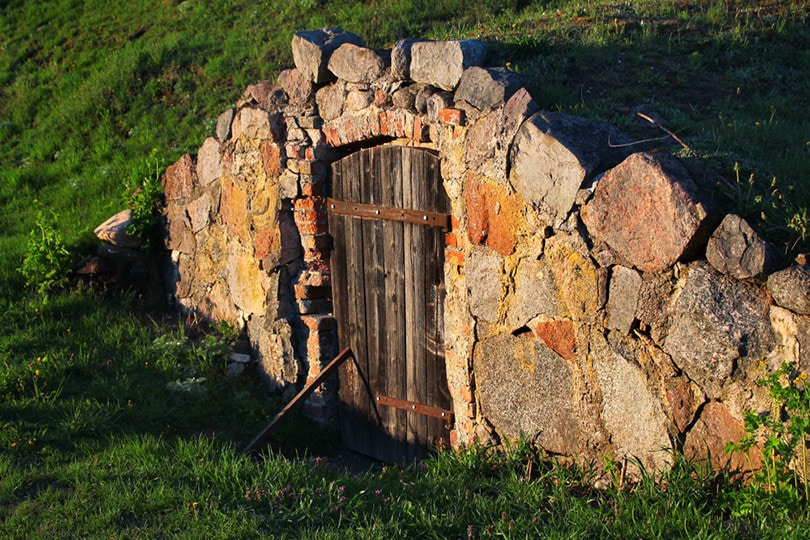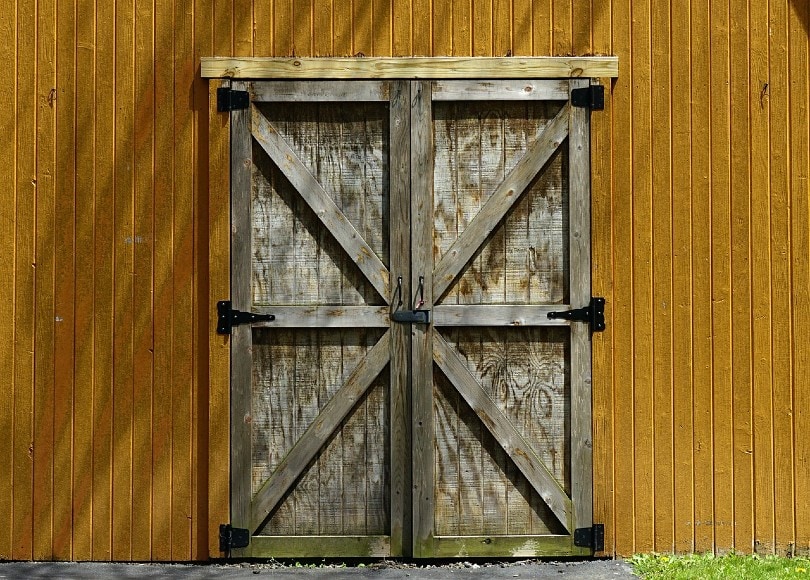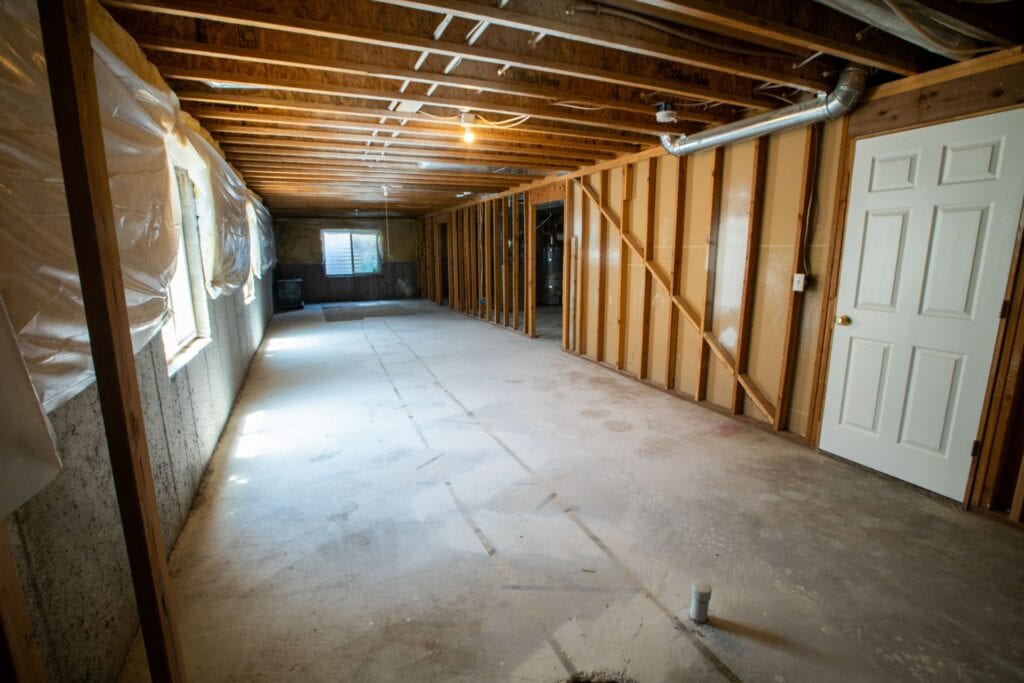What Is a Root Cellar? Pros, Cons & FAQ
-
Pete Ortiz
- Last updated:

Most homes throughout the US have a space below the house that most people call a basement. However, not all underground chambers are basements, and some homes have root cellars. Many confuse the two spaces, but they are entirely different and don’t serve the same purpose. A root cellar is a structure under the ground people use to store fruits, vegetables, nuts, and other foods.
Although both structures are located under ground level, their means of usage are not similar. Check out the rest of our article if you’d like to learn how to differentiate a root cellar from a basement and know their most significant dissimilarities.
What Is a Root Cellar?
Some people use them to store beer, wine, or other alcoholic beverages. Although they are commonly entirely underground, root cellars could also be partially underground, depending on your property’s available space.
The reason behind root cellars having at least a portion of the cellar underground is that such an environment provides excellent storing conditions for food. Typically, the temperature in root cellars is between 32℉ and 40℉, and the humidity rate is pretty stable. These structures use the earth’s naturally insulating, humidifying, and cooling properties to keep your food in good shape.
Commonly, root cellars have concrete, wood, or sandbag walls, and the space has ventilation to keep your stored food edible for a long time. They are typically larger than basements and have more entrances/exits.

What Is a Basement?
A basement is also a structure wholly or partially underground, although instead of storing food, people mainly use it as a utility space. Commonly, you’ll see people convert basements into additional living space, adding a bonus room, office, gym, or even a laundry room into the area.
It’s convenient to have a basement because you could turn it into anything that comes to your mind, increasing the square footage and value of your home.
What Are the Different Types of Root Cellars?
The design of a root cellar needs to hold a specific humidity and temperature range to function correctly. As the essence of a root cellar is a container or a space buried under the ground, there are various designs you can select.
- Below-structure root cellar: You can have a root cellar under the ground, below your home, or with a shed above the cellar.
- Above-ground root cellar: You can also build a root cellar above the ground, but you’ll need to pile up soil and rocks to create a hill or berm. It will be as if the structure was partially under the ground.
- Hill root cellar: If you have a small hill in your yard, you could use it as an advantage and build a cellar inside. That will make the process easier as there’s no need for digging.
- Barrel root cellar: An excellent choice for people who don’t have a lot of food they need to store. You could bury a barrel under the ground and keep the food inside.
- Traditional root cellar: A structure built under the ground during the house building process. These types of root cellars typically have a separate entrance from the home.
Where and Why Do People Use Root Cellars?
Anyone who wants a place to store their food can build a root cellar to keep their crops stored and ready for use. You can add shelves and store all kinds of vegetables, fruits, and other foods that will remain fresh until you need to use them. Root cellars are incredibly convenient for people who grow their own food, as they’ll make it into a worthwhile investment that will store all their produce after harvest time.
If your home doesn’t have a root cellar, but you like the idea of having one, you could build one pretty quickly, although they can be an expensive investment. It’s an ideal type of storage as you won’t need to spend any electricity, which will lower your utility costs.
Advantages of Root Cellars
Overall, a root cellar is an excellent investment for people who produce and store lots of food throughout the year. This type of structure will have multiple benefits, so it’s a perfect way to preserve your crops and prevent their decomposition.
- Food security and quality
- Extra storage space
- Require little energy and maintenance
- Saves money
- No need for electricity
- Prevents the decomposition of crops
- Storage for various foods and drinks
- Sustainable and eco-friendly

Disadvantages of Root Cellars
Everything in this world has benefits and disadvantages, and so do root cellars. Although they can be a fantastic, functional space for many households, there are things to consider before building a root cellar.
- Expensive to build
- Could be inconvenient to access
- It takes time to learn how your root cellar functions properly
Most Significant Differences Between a Root Cellar and a Basement
Purpose
People use root cellars to store food products and keep them fresh throughout the year. Because of the conditions in root cellars, they cannot be used as additional living space and are strictly there for storage purposes.
On the other hand, basements are typically used as additional space. People convert them into bonus rooms, offices, bedrooms, or any other needed space that will benefit their home. A big advantage of a basement is that you can also convert a basement into a root cellar. However, you wouldn’t be able to convert a root cellar into a basement.

Conditions
Basements are supposed to be warm and moisture-free. They are intended as additional living space, so a basement should have the same conditions as the rest of your home. However, root cellars need to be moist, cool, and humid to preserve your crops for a long time.
Maintenance
Basements will require regular maintenance like any other part of your house. You’ll need to clean them and keep them moisture-free. Overall, they need much more maintenance than root cellars.
When it comes to root cellars, you’ll need to keep them ventilated and moisturized, but other than that, they don’t require any specific maintenance.
Frequently Asked Questions
Can you use your basement as a root cellar?
If you have a basement that’s turned into additional living space, it won’t function as a root cellar. That’s because a root cellar needs specific structural plans and materials to maintain the necessary humidity and temperature for storing crops.
However, if you want to have a root cellar, you can go through the process of converting the basement into one. Adding certain modifications could turn a portion of, or the entire basement into a root cellar.
How do I turn my basement into a root cellar?
Before you start building a root cellar in your basement, you should carefully select the area for the root cellar and make structural plans for the project. Primarily, you should check if such work requires a permit, as changing your basement without one could lead to fines and other issues.
If you don’t want to convert the whole basement, it’s best to choose a corner that you’ll transform. You’ll need to select materials for the process, and it’s best to choose moisture-resistant products. You can use plywood, stone, and rocks.
Another critical thing you need to invest in is proper insulation that will keep the temperature and humidity levels balanced. You’ll also need to consider ventilation as it’s crucial for a functioning root cellar. If you don’t know where to start, we suggest hiring a contractor to help you with the process.
Which foods can you store in a root cellar?
A root cellar is suitable for storing all kinds of foods, and people mainly use them to store:
- Vegetables (Potatoes, carrots, turnips, cabbages, beets, onions, peppers, garlic)
- Fruits (Apples, pumpkins, squashes
- Canned food (Canned pickles, jams)
- Nuts (Walnuts, hazelnuts)
- Dairy products (Milk, cheese)
Conclusion
If you need additional space for your everyday activities, it’s better to have a basement, while root cellars are more convenient for storing food products. If you have a basement, but also need storage space for your crops, consider turning a portion of the basement into a root cellar, as it will be beneficial for you and your household.
Featured Image Credit: Imfoto, Shutterstock
Contents


